Harvard University’s endowment has nearly tripled its stake in BlackRock’s iShares Bitcoin Trust to about $443 million, making Bitcoin its largest publicly disclosed U.S. holding. Emory University and sovereign wealth funds are also piling into Bitcoin ETFs — even as spot ETFs see billions in outflows and BTC falls under $90,000.
Key Takeaways
- Harvard’s endowment has lifted its stake in BlackRock’s iShares Bitcoin Trust (IBIT) to roughly 6.8 million shares worth about $442–443 million, a jump of more than 250% in Q3 2025. [1]
- Bitcoin ETFs are experiencing heavy outflows — more than $2.3–2.6 billion so far in November — as Bitcoin’s price drops below $90,000, its lowest level in seven months. [2]
- Emory University, a Georgia‑based institution, has doubled down on Bitcoin via the Grayscale Bitcoin Mini Trust, lifting its position to around $52 million while also adding a sizeable gold ETF stake. [3]
- Sovereign wealth funds such as Abu Dhabi’s Al Warda Investments have sharply increased their IBIT exposure, underscoring a broader institutional shift toward regulated crypto products. [4]
- Harvard and other endowments are pairing Bitcoin exposure with bigger gold positions, framing both assets as long‑term hedges and diversification tools rather than short‑term trades. [5]
Harvard’s Bitcoin ETF Is Now Its Biggest Public Stock Holding
New SEC 13F filings released in mid‑November show that Harvard Management Company (HMC), which oversees Harvard University’s roughly $57 billion endowment, has dramatically increased its exposure to Bitcoin via BlackRock’s iShares Bitcoin Trust (IBIT). [6]
According to those disclosures and multiple market analyses:
- Harvard now holds about 6.8–6.81 million IBIT shares. [7]
- The position was valued at roughly $442–443 million as of September 30, 2025, based on quarter‑end prices. [8]
- That’s up from around 1.9 million shares worth about $116–117 million in Q2 2025, meaning Harvard more than tripled its stake — an increase of roughly 250–280%, depending on whether you measure by share count or dollar value. [9]
Crucially, IBIT is now Harvard’s largest publicly disclosed U.S. equity holding, surpassing high‑profile positions in tech giants such as Microsoft, Amazon, Alphabet and Meta. [10]
Yet in terms of the overall endowment, this is still a relatively small slice: roughly 0.6% of Harvard’s total assets, according to aggregated ETF ownership data cited by multiple outlets. [11]
Why This Move Matters
University endowments are famously conservative, often favoring bonds, private equity, and blue‑chip stocks over anything that looks speculative. That’s why Harvard’s decision to make a spot Bitcoin ETF its biggest public holding is being treated by ETF analysts as a watershed moment — “about as strong a validation as an ETF can get,” one prominent ETF watcher commented on social media, noting how rare it is for large endowments even to touch a new asset class. [12]
In other words, Harvard isn’t just dabbling in crypto — it’s signaling that Bitcoin, when wrapped in a regulated ETF, now belongs in the same conversation as other institutional‑grade assets.
A Paired Bet: Bitcoin and Gold
Harvard’s Q3 filings show that its conviction extends beyond digital assets alone. While IBIT has become the largest public holding, HMC also doubled its position in the SPDR Gold Trust (GLD), lifting its stake from about $101.5 million to roughly $235 million. [13]
Taken together, these moves paint a clear picture:
- Bitcoin exposure via IBIT (~$443 million)
- Gold exposure via GLD (~$235 million)
Both assets are being used as hedges and diversifiers rather than direct, physical holdings of gold bars or self‑custodied Bitcoin. They allow Harvard to tap into “hard asset” characteristics while remaining inside a familiar ETF framework. [14]
Academic commentators quoted in Harvard‑focused coverage note that investors often view both Bitcoin and gold as potential hedges against deep stress in the global monetary system and against long‑term erosion of confidence in the U.S. dollar — though they stress that the evidence such assets reliably hedge inflation or volatility is still mixed and highly scenario‑dependent. [15]
Emory University Joins the Crypto ETF Club
Harvard is no longer alone. Emory University, a private research university based in Georgia, has also significantly increased its Bitcoin exposure, providing an important second data point in the higher‑education world.
In a Q3 2025 13F filing:
- Emory reported more than 1 million shares of the Grayscale Bitcoin Mini Trust, up from about 487,000 shares in the prior quarter. [16]
- At quarter‑end prices, that stake was valued at around $52 million — roughly in line with separate coverage describing a “$51–52 million Bitcoin ETF bet” from a Georgia‑based university. [17]
- Emory also opened a new position of nearly $79 million in BlackRock’s iShares Gold Trust (IAU), echoing Harvard’s “Bitcoin plus gold” strategy. [18]
Emory maintains a much smaller IBIT position — valued at roughly $290,000 — and has modestly increased its stake in Coinbase stock, suggesting broader comfort with crypto‑related assets across both ETF and equity markets. [19]
For an institution that historically favored conservative allocation, this is a noteworthy tilt toward regulated crypto exposure as a long‑term diversifier, not just a speculative trade.
Sovereign Wealth Funds Are Moving Too
It isn’t just universities. Sovereign wealth funds are quietly climbing the same ladder.
Recent breakdowns of ETF ownership data highlighted in today’s market summaries show that Abu Dhabi’s Al Warda Investments has boosted its IBIT holdings by roughly 230%, to about 7.96 million shares — a position worth around $517.6 million. [20]
That places the fund among the largest institutional owners of BlackRock’s Bitcoin ETF and underscores the appeal of spot Bitcoin ETFs for state‑backed investors, who benefit from:
- Regulatory clarity in U.S. markets
- Institutional‑grade custody via ETF structures
- Instant liquidity compared with direct crypto holdings
Harvard’s presence alongside a sovereign wealth fund in the same ETF cap table is a powerful signal: Bitcoin is increasingly being treated as a serious reserve‑style asset by some of the world’s largest pools of capital.
The Paradox: Big Bets While ETFs Bleed Billions
All of this is happening against a remarkably turbulent backdrop.
On Tuesday, Bitcoin briefly dropped below $90,000, its lowest level in seven months, before rebounding slightly later in the day. [21]
According to data compiled by ETF and crypto‑market trackers:
- Spot Bitcoin ETFs have seen roughly $2.3–2.6 billion in net outflows so far in November, approaching February’s record monthly outflow. [22]
- One recent report notes that the 11 U.S. spot Bitcoin ETFs lost over $800 million in just two trading sessions last week, with BlackRock’s IBIT alone posting a single‑day outflow of about $463 million. [23]
- Bitcoin is down about 13% from its October peak, dragging many ETF investors temporarily into the red. [24]
Despite the selling, market strategists quoted by Decrypt and other outlets characterize the move as a “risk‑management phase” rather than a broad institutional exodus, pointing to profit‑taking and portfolio rebalancing after crypto’s outsized post‑2023 rally. [25]
In that light, Harvard and Emory’s Q3 filings can be read as contrarian:
- They accumulated Bitcoin before November’s deeper pullback became visible in prices.
- Their long‑term horizon means short‑term drawdowns are less important than the strategic role Bitcoin might play in portfolios over a decade or more. [26]
Altcoin ETFs: Rotation, Not Retreat
While Bitcoin ETFs face outflows, capital is not leaving the crypto ETF universe altogether — it’s pivoting.
Recent flows tracked by institutional research outfits show:
- Altcoin ETFs have attracted around $243 million in net inflows, as investors look for diversification beyond Bitcoin. [27]
- A newly launched XRP ETF reportedly drew about $243 million on its debut, with Solana and Litecoin‑linked products also seeing positive flows. [28]
This suggests a more nuanced picture:
- Some investors are locking in profits on Bitcoin after a multi‑year run.
- Others are reallocating within crypto, not abandoning the asset class entirely.
In that context, Harvard and Emory’s buy‑and‑hold approach to Bitcoin ETFs looks less like a speculative chase and more like a structural allocation, while swing‑traders and hedge funds shuffle between narratives in the shorter term.
Why University Endowments Are Warming to Bitcoin ETFs
So what’s driving institutions like Harvard and Emory to make these moves now?
1. Regulated, Familiar Wrappers
Spot Bitcoin ETFs like IBIT and the Grayscale Bitcoin Mini Trust offer:
- Regulated listings on major exchanges
- Professional custody and auditing
- Straightforward accounting and reporting for compliance teams
For committees that would balk at managing private keys or interacting with exchanges directly, ETFs strip away operational friction while preserving price exposure. [29]
2. Diversification and Hedge Potential
Commentators quoted in Harvard‑focused coverage argue that both Bitcoin and gold are being used as partial hedges against macro‑level uncertainty, from fiscal imbalances to geopolitical tensions and the long‑term trajectory of fiat currencies. [30]
Even skeptics concede that allocating a small fraction of a diversified portfolio to Bitcoin can enhance diversification, provided the investor can tolerate significant volatility.
3. Generational Alignment and Institutional Signaling
Universities — especially elite ones like Harvard — are under pressure from students, alumni, and donors to stay relevant:
- Exposure to digital assets signals forward‑looking thinking.
- It may also help appeal to younger donors who already hold crypto.
By using regulated ETFs rather than direct token holdings, endowments can balance innovation with responsibility.
What This Means for Crypto and Traditional Finance
Harvard’s and Emory’s moves won’t single‑handedly determine Bitcoin’s price, but they matter for at least three reasons:
- Legitimacy: When the world’s largest academic endowment makes a Bitcoin ETF its biggest public position, it chips away at the perception that crypto is purely speculative or fringe. [31]
- Copycat Risk (or Opportunity): Other universities, foundations, and pension funds watch Harvard closely. Even a handful of copycat allocations in 2026 could translate into billions more in institutional demand for Bitcoin ETFs.
- Policy and Regulation: As more “blue‑chip” institutions hold spot Bitcoin ETFs, regulators and policymakers face rising pressure to provide clear, stable rules around taxation, custody, and reporting — because the stakeholders now include students, retirees, and sovereign wealth beneficiaries.
The Bottom Line (and a Big Caveat)
On November 18, 2025, the picture that emerges is paradoxical but clear:
- Prices and flows look ugly in the short term: Bitcoin is testing sub‑$90,000 levels, and ETFs have hemorrhaged more than $2 billion this month. [32]
- But some of the world’s most conservative institutions are quietly building long‑term positions, treating Bitcoin as a strategic asset alongside gold rather than a passing fad. [33]
For individual investors, it’s crucial to remember:
This article is for information only and does not constitute financial or investment advice. Bitcoin and crypto‑related ETFs remain highly volatile and risky. Anyone considering exposure should carefully evaluate their risk tolerance, time horizon, and local regulations, and consider seeking independent professional advice.
References
1. www.thecrimson.com, 2. decrypt.co, 3. www.coindesk.com, 4. www.ainvest.com, 5. www.thecrimson.com, 6. www.thecrimson.com, 7. www.bitget.com, 8. www.thecrimson.com, 9. www.bitget.com, 10. www.thecrimson.com, 11. www.ainvest.com, 12. m.fastbull.com, 13. www.thecrimson.com, 14. www.thecrimson.com, 15. www.thecrimson.com, 16. www.coindesk.com, 17. www.coindesk.com, 18. www.coindesk.com, 19. www.coindesk.com, 20. www.ainvest.com, 21. decrypt.co, 22. www.ainvest.com, 23. www.ainvest.com, 24. www.ainvest.com, 25. decrypt.co, 26. www.coindesk.com, 27. www.ainvest.com, 28. www.ainvest.com, 29. gizmodo.com, 30. www.thecrimson.com, 31. www.thecrimson.com, 32. decrypt.co, 33. www.thecrimson.com








